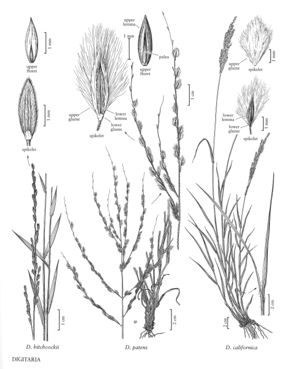Difference between revisions of "Digitaria patens"
FNA>Volume Importer |
FNA>Volume Importer |
||
| Line 19: | Line 19: | ||
-->{{Treatment/Body | -->{{Treatment/Body | ||
|distribution=Tex. | |distribution=Tex. | ||
| − | |discussion=<p>Digitaria patens is endemic to southwestern and southern Texas and adjacent Mexico. It grows in well-drained, usually sandy, soils, often in disturbed habitats. Gould (1975) suggested that it might be an octoploid derivative of D. californica.</p> | + | |discussion=<p><i>Digitaria patens</i> is endemic to southwestern and southern Texas and adjacent Mexico. It grows in well-drained, usually sandy, soils, often in disturbed habitats. Gould (1975) suggested that it might be an octoploid derivative of <i>D. californica</i>.</p> |
|tables= | |tables= | ||
|references= | |references= | ||
| Line 40: | Line 40: | ||
|publication year= | |publication year= | ||
|special status= | |special status= | ||
| − | |source xml=https://jpend@bitbucket.org/aafc-mbb/fna-data-curation.git/src/ | + | |source xml=https://jpend@bitbucket.org/aafc-mbb/fna-data-curation.git/src/8f726806613d60c220dc4493de13607dd3150896/coarse_grained_fna_xml/V25/V25_1065.xml |
|subfamily=Poaceae subfam. Panicoideae | |subfamily=Poaceae subfam. Panicoideae | ||
|tribe=Poaceae tribe Paniceae | |tribe=Poaceae tribe Paniceae | ||
Revision as of 16:28, 18 September 2019
Plants perennial; cespitose, neither rhizomatous nor stoloniferous. Culms 40-90 cm, erect, sometimes geniculate, not rooting, at the lower nodes. Leaves mainly cauline; basal sheaths villous; upper sheaths glabrous or sparsely to densely hirsute, hairs papillose-based; ligules (1)1.5-4 mm, entire to lacerate; blades 5-15 cm long, 1-4 mm wide, glabrous or sparsely pubescent. Panicles with 4-10 spikelike primary branches on (4)10-18 cm rachises; primary branches 4-10 cm, usually divergent at maturity, varying to ascending, axes not wing-margined, bearing spikelets in unequally pedicellate pairs; internodes (4.5)6-15 mm (mid-branch); secondary branches rarely present; shorter pedicels 2-2.5 mm; longer pedicels 7-8 mm; terminal pedicels of primary branches 7.4-20 mm. Spikelets homomorphic, 3.7-5.8 mm (including pubescence), 2.9-4.3 mm (excluding pubescence). Lower glumes 0.3-0.5 mm; upper glumes 2.4-3.5 mm (excluding pubescence), 3-veined, densely villous, hairs 1.5-4 mm, silvery-white to purple, spreading at maturity; lower lemmas 2.8-4.2 mm (excluding pubescence), exceeding the upper lemmas by 0.8-2.2 mm, 5-veined and the veins equally spaced or 7-veined and the lateral veins closer to each other than to the central vein, margins densely villous, hairs 1.5-4 mm, silvery-white to purple, spreading at maturity, apices acuminate; upper lemmas 2.6-3.2 mm, lanceolate, brown when immature, dark brown at maturity, acuminate. 2n = 72.
Discussion
Digitaria patens is endemic to southwestern and southern Texas and adjacent Mexico. It grows in well-drained, usually sandy, soils, often in disturbed habitats. Gould (1975) suggested that it might be an octoploid derivative of D. californica.
Selected References
None.
